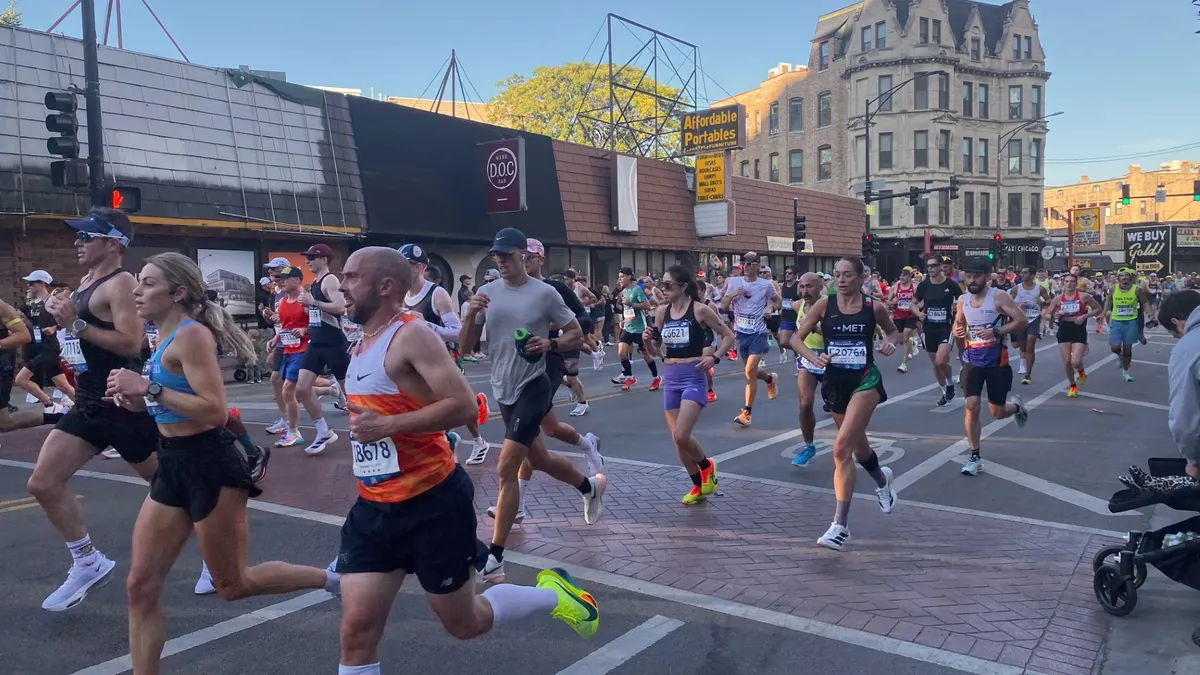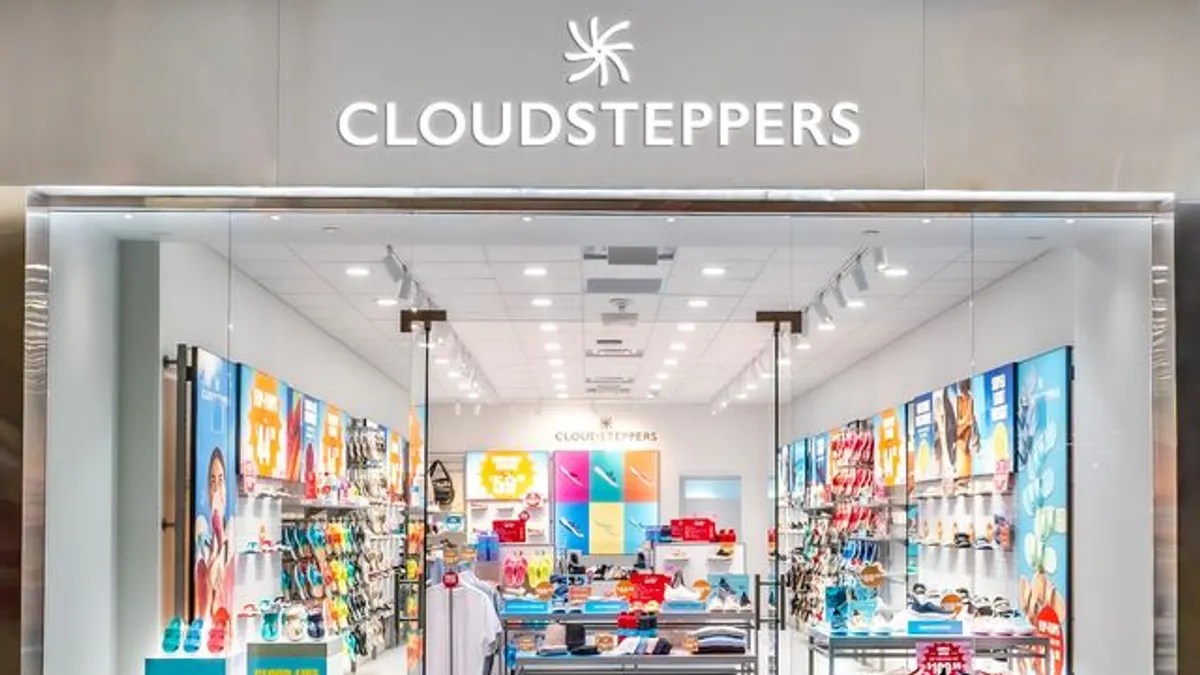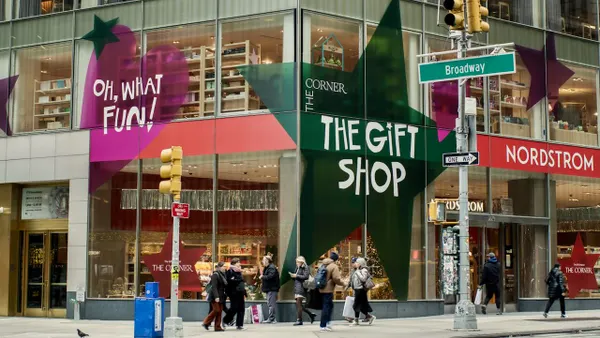Rocksbox began in 2012 in a San Francisco apartment. Five years and $11.5 million in funding later, Rocksbox Founder and CEO Meaghan Rose is well on her way of creating "the Sephora of jewelry" – a subscription-based jewelry concept with a clear path toward growth.
In just five years, what began as an apartment-based business that had Rose loaning out her own collection, has grown to include a number of establish jewelry makers and boasts eight private brands.
Retail Dive sat down with Rose to find out more.
RETAIL DIVE: How did you got the idea for Rocksbox?
ROSE: This is back in 2011, when I had the benefit of working with these big incumbent players. At that time Gilt was blowing up and Rent the Runway had just started. As somebody who worked in retail for a long time and studied consumer behavior in business school, I was starting to get really excited about how it seems obvious that retail was at the beginning of what I thought would be a really big evolution in how people were shopping.
I was sort of inspired by Sephora actually, because I felt like Sephora had really reinvented the shopping experience in beauty in this way that was very customer oriented. It was [about] how women make decisions when it comes to buying makeup. They fall in love with something by trying it out, by playing with it. So I kind of started toying with that idea and I fell in love with the jewelry category, I felt like it was a space that was really broken — it's very fragmented, it's very intimidating. There are thousands of designers out there and it's hard to know if you're really going to love something when you just look at it on the shelf somewhere.
So, I started thinking about if I were to create a shopping experience, just to re-imagine it, for jewelry what would that look like. I came up with this idea of instead of having all of this product just sitting around in the warehouse or on a shelf somewhere, why don't you just send it to the customer and let her wear it and then she can decide if she wants to buy it or not. That is still really the heart of Rocksbox, which is just this idea of taking the onus away from the buyer to come to you and taking the product and sending it to her.
The idea was that as data and technology is evolving, we can actually stop thinking about merchandising at a large scale mass level and start thinking about merchandising and creating a retail experience on an individual level. And how powerful that is to think about building a pipeline into our customers' home where we're sending her product and she can really have an opportunity to wear it and fall in love with it that way.
That's all sort of the philosophical idea of what Rocksbox is, but tactically what the business model turned into was this subscription, membership-based service where members pay $21 a month. She gets three pieces of jewelry at a time that have been picked out for her through a combination of a lot of things. She can wear that jewelry for as long as she wants, she can send it back at any point and she can buy anything that she loves by just keeping it. We just charge her account.
RETAIL DIVE: She can just cycle through and say I want three new pieces and always have something new?
ROSE: Exactly, it's like having this ever-rotating closet of new jewelry to wear instead of saying I'm going to splurge and spend $100 on one necklace. You get new jewelry all the time. Then if you do find something that you absolutely love and know you're going to wear it enough, then that's the thing that you splurge on.
"Over 40% of our shipments result in a purchase. Jewelry is a very attractive category from a margin perspective. It's also really lightweight, there are no sizes, so there's low inventory complexity."

Meaghan Rose
Founder & CEO, Rocksbox
RETAIL DIVE: The metrics are very interesting. How are subscription models making money? Because the returns can be pricey, and the packaging is costly, especially since unboxing is important in these categories.
ROSE: Our business model is structured with two revenue streams. We have the membership fee and we have the purchases. For us, the business really works because we have such high purchase conversion. Generally, over 40% of our shipments result in a purchase. Jewelry is a very attractive category from a margin perspective, it's also really lightweight, there are no sizes, so low inventory complexity. It's really durable. We've invested a lot in the backend logistics and the reverse logistics to support this business model, as well as the cleaning and sterilization and repackaging. And just doing that at scale so that we can have good margins on the fulfillment side, put that back into the customer experience, the packaging and all that.
That, coupled with the fact that we have this high purchase conversion and a high margin category, makes the business model work really well for us.
RETAIL DIVE: Walk me through the funding process.
ROSE: In 2012 I started this as a WordPress website. It was my own jewelry, I learned a little bit of Photoshop, made a logo, that kind of thing, super scrappy. We raised our first outside capital in 2014 and that's when we really were able to build a team and start sussing out growth channels and recruiting new designers. We grew 10 times with that round. We closed our Series A two years later in 2016, and we're continuing to scale really well so it's been definitely an exciting time. We moved our fulfillment to Columbus, OH last year and so that's allowed us to promote customer growth expansion as well.
RETAIL DIVE: Why Columbus?
ROSE: We looked at a lot of different locations and we wanted something that was central just from a shipping time perspective. There are a lot of considerations, cost of labor, proximity to other distribution centers and different partners that we were interested in working with. That's been great for us as well. Before that we were doing all of our fulfillment in-house.
RETAIL DIVE: Out of San Francisco? That's costly.
ROSE: It was costly. It was in this really old basement building that should be condemned probably. But it was fun and we were close to the product and we learned a ton. It was appropriate. It was the right time to move it when we did, but that experience has been really valuable for us.
RETAIL DIVE: What were your biggest challenges in terms of raising money?
ROSE: Where do I start? I think in general, venture-backed companies are traditionally strictly technology businesses. I think that the venture universe is still figuring out how to think about a consumer and commerce-related [business] specifically as it sits inside the technology investment world. The kind of investments you have to make are very different. You have your customer acquisition costs, you have your inventory costs, and then you have the technology costs, as well. There are just different challenges that come with that.
One of the things that I found is that there are some investors really interested in investing in this kind of business and it's really smart to figure out who they are and go after those, rather than trying to chase down every tech investor out there. When it comes to telling a great story, being able to really say "this is a good investment and here's why" in the consumer space. A lot of it is about what is your growth, how much does it cost to grow and what's the value of the customer that you're bringing onboard — that's what makes a healthy business.
Then really the long-term vision for the business, [is] how are you going to build this into a billion dollar company? That's having an exciting vision, that we're going to be one of the big players that's ultimately redefining the retail landscape and what we're doing right now is [building] the platform for growing into that. Within subscription in particular, things like retention are really important and retention with consumer's really different than retention in SaaS, for example.
A lot of times in games and other categories you have high churn with the early customers, but then you have these lifers that will stick around for a long time and that's a really important signal in terms of a healthy subscription type of business. You have at least some people saying, "this is changing the way I do grocery shopping or jewelry shopping or clothes shopping or whatever it is, so much that it's replacing my old way of doing that." That's how you know you're really building something meaningful long-term, and I think that's what investors are looking for.
RETAIL DIVE: There are some people who are wondering where's the tipping point in subscriptions, how many can we have in the market right now? What's your viewpoint on that?
ROSE: My viewpoint is that traditional retail — it's really just a distribution model and stores are really just distribution points. Customers they go to the store, they kind of look around and decide what they want. Technology and data is evolving so much that we can anticipate what people want. Sometimes it's really easy, like paper towel subscriptions, and sometimes it's a little harder like jewelry, where there's a lot of taste involved. But the pace of change in technology and data science is so rapid right now that we're getting so fast and we're really cutting out the points of friction along the way.
Alexa is one way in which that's happening already. It really becomes more about the service aspect and being able to know what the customer wants, and get it in front of him or her before she even has to ask for it. Then it really makes sense that you're subscribing to certain services. It's that service that you're paying for, whether that's structured as a subscription or something else. Personally I think that there's still a lot of space for us to think about where subscription makes sense if you're thinking about it as retail, as a service. If you have certain retailers that know you better than anyone else and provide a better service, then committing to them is actually easier then to have to make that decision every single time you want a new thing.
So I think subscription can replace a lot of our purchase decisions. Subscription, the way it looks now where I subscribe to razors or jewelry or whatever, I think is most successful in categories where you have some replenishment, some natural replenishment. But that replenishment cycle can vary a lot and I do think that the idea of subscribing to different brands as service providers that are doing the discovery and the distribution for you, is super interesting and really exciting — and I think there's still a long way to go there.
RETAIL DIVE: When you look down the road, what is your long view for Rocksbox?
ROSE: For me, what I really think is exciting is to build a Sephora of jewelry type concept, where we have built a brand that has become known as the destination for all things jewelry and accessories. Where people trust us to have the trends and the classics, the best brands and good quality. Where we have more data about the category than anyone else. So we know exactly what you want, when you want it and if you want it just for the weekend or if you want to own it. We cut out the need for you to go anywhere else to look for things in this category.





















